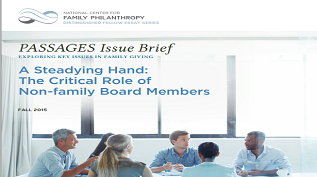What are some points we should consider as a family foundation seeking a non-family board member?

What are some points we should consider as a family foundation seeking a non-family board member?
Editor’s Note: This is an excerpt from “A steadying hand: The critical role of non-family board members,” written by NCFP Distinguished Fellow Susan Packard Orr. This first Distinguished Fellow Essay provides insight on the various skills, expertise, and perspectives that a non-family board member can provide, as well as the common challenges for families seeking their first non-family board member, and tips for setting clear expectations for this role.
Setting Clear Expectations
If you are thinking about adding non-family trustees, what are some of the things you might consider?
- Job description/role: Be clear about the role you expect the non-family trustee to play. Will she be a full member of the board with voting rights or more in an advisory role? If you write a job description, it allows everyone, both family and non-family trustees, to agree on expectations. It can be delicate to walk the line between being clear that yours is a family foundation, ultimately controlled by the family, and the desire to be open to ideas and direction from non-family trustees. It should be obvious that you are inviting a non-family trustee to join your family in its philanthropic work, and not for the purpose of funding his pet projects.
- Criteria for selection: Make a list of attributes that you are looking for. This might include personal qualities, experience on other boards, and a passion for your program interests. If you are lacking specific skills on your board, like finance or HR, include those in your list. Above all, non-family trustees must embrace the concept of a family foundation and be willing to work within that framework.
- Selection process: Determine your process for selecting new trustees. Do you have a governance committee or will this be handled by the full board? How will you generate names of potential members? Do you need a process for a family member to veto a potential selection if they feel strongly? One method is to circulate a potential name confidentially among all board members, asking anyone with concerns or objections to contact the committee or board chair. • Terms – determine how long you are asking a non-family trustee to serve. What is the process for evaluating performance and deciding if you want to ask a trustee to serve a second or third term? Consider a way to gather input from the non-family trustees about their experience on the board that you can use to improve board functioning.
- Conflict of interest: A robust conflict of interest policy is important for any foundation, with or without non-family trustees. But when you add non-family trustees, it is especially important that this policy is understood by everyone. For example, if a trustee is a board member of a grantee organization, she should abstain from voting on grants to that organization. You may wish to go further, and require that she recuse herself from the discussion.
- Other policies: If you have discretionary grant-making or matching grants for individual board members, you need to decide whether these will be extended to non-family trustees. Nonfamily trustees will likely not have a satisfying experience on your board if you leave them out of all grant-making decisions. If your grant-making is entirely discretionary, with little or no budget for the board as a whole to allocate, adding non-family trustees may not make sense for your foundation.
